Bumping, also known as passing, is a fundamental skill in volleyball. It’s the first contact your team makes with the ball after it comes over the net and sets the stage for your attack. Mastering this technique is crucial for any aspiring volleyball player. This guide will provide a detailed breakdown of how to execute a perfect bump, covering everything from hand positioning to footwork and common mistakes to avoid.
Getting Started: The Perfect Bump Stance
Before you even touch the ball, your stance is key. Imagine yourself getting ready to receive a fast-moving object. You wouldn’t stand stiffly, right? Instead, you’d adopt a balanced, athletic position. The same applies to volleyball. Stand with your feet shoulder-width apart, knees bent, and your weight balanced evenly. Your upper body should be slightly leaned forward. Extend your arms in front of you, slightly below waist level, and create a platform by placing one forearm on top of the other, hands clasped together. This platform will be your primary contact point with the ball.
Hand Positioning and Platform Formation
 Close-up of hands clasped together forming a flat surface for bumping.
Close-up of hands clasped together forming a flat surface for bumping.
The key to a good bump is a flat platform. Avoid bending your wrists or letting your elbows flare out. Instead, keep your arms straight and your wrists firm. Your hands should be clasped together, thumbs side by side, creating a flat surface. Think of your forearms as a single, solid unit. This flat platform ensures the ball rebounds cleanly and predictably.
Footwork and Movement
Volleyball is a dynamic sport, and you’ll rarely be standing still when you receive the ball. Develop the habit of shuffling your feet to get into position. Don’t cross your feet, as this can throw off your balance. Instead, use small, quick steps to move laterally and get directly under the ball. Anticipate the trajectory of the ball and move proactively. Your goal is to make contact with the ball in front of your body, slightly below waist level.
Making Contact: The Art of the Bump
Contacting the ball involves more than just letting it hit your forearms. You need to use your legs to generate power and control the direction of the pass. As the ball approaches, extend your legs slightly upwards, transferring your weight forward. Meet the ball with your platform and angle it towards your target. Avoid swinging your arms. The power for your bump should come from your legs, not your arms. Imagine pushing the ball towards your setter with a controlled, upward motion.
Common Mistakes and How to Avoid Them
- Swinging your arms: Remember, bumping is not hitting. The power should come from your legs.
- Bending your wrists: A flat platform is essential for a consistent bump. Keep your wrists firm and straight.
- Not moving your feet: Volleyball is a game of movement. Shuffle your feet to get under the ball.
- Looking down at the ball: Keep your eyes on the ball as it approaches, but shift your focus to your target as you make contact.
Advanced Bumping Techniques
Once you’ve mastered the basics, you can start experimenting with more advanced techniques, such as the overhand dig or the pancake dig. These techniques are used for more difficult balls, such as hard-driven spikes or tips.
Conclusion
Mastering the bump is a journey that requires practice and patience. By focusing on the fundamentals – stance, hand position, footwork, and contact – you’ll be well on your way to becoming a proficient volleyball player. Remember, consistency is key. Practice regularly and focus on developing good habits. With time and dedication, you’ll be bumping like a pro in no time!
FAQ
- What is the difference between a bump and a dig?
- How can I improve my bumping accuracy?
- What are some drills to practice bumping?
- How important is footwork in bumping?
- What is the ideal height to bump the ball?
- How can I avoid getting bruised when bumping?
- How can I practice bumping alone?
Need assistance? Contact us at Phone Number: 0372960696, Email: TRAVELCAR[email protected] or visit us at 260 Cau Giay, Hanoi. We have a 24/7 customer support team.

